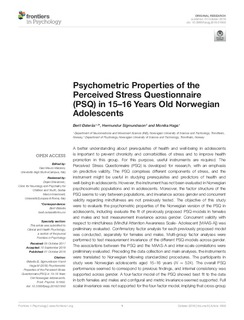| dc.contributor.author | Østerås, Berit | |
| dc.contributor.author | Sigmundsson, Hermundur | |
| dc.contributor.author | Haga, Monika | |
| dc.date.accessioned | 2018-10-04T10:54:53Z | |
| dc.date.available | 2018-10-04T10:54:53Z | |
| dc.date.created | 2018-10-02T10:49:09Z | |
| dc.date.issued | 2018 | |
| dc.identifier.issn | 1664-1078 | |
| dc.identifier.uri | http://hdl.handle.net/11250/2566389 | |
| dc.description.abstract | A better understanding about prerequisites of health and well-being in adolescents is important to prevent chronicity and comorbidities of stress and to improve health promotion in this group. For this purpose, useful instruments are required. The Perceived Stress Questionnaire (PSQ) is developed for research, with an emphasis on predictive validity. The PSQ comprises different components of stress, and the instrument might be useful in studying prerequisites and predictors of health and well-being in adolescents. However, the instrument has not been evaluated in Norwegian psychosomatic populations and in adolescents. Moreover, the factor structure of the PSQ seems to vary between populations, and invariance across gender and concurrent validity regarding mindfulness are not previously tested. The objective of this study were to evaluate the psychometric properties of the Norwegian version of the PSQ in adolescents, including evaluate the fit of previously proposed PSQ-models in females and males and test measurement invariance across gender. Concurrent validity with respect to mindfulness (Mindful Attention Awareness Scale- Adolescent [MAAS-A]) was preliminary evaluated. Confirmatory factor analysis for each previously proposed model was conducted, separately for females and males. Multi-group factor analyses were performed to test measurement invariance of the different PSQ-models across gender. The associations between the PSQ and the MAAS-A and inter-scale correlations were preliminary evaluated. Preceding the data collection and main analyses, the instruments were translated to Norwegian following standardized procedures. The participants in study were Norwegian adolescents aged 15–16 years (N = 524). The overall PSQ performance seemed to correspond to previous findings, and internal consistency was supported across gender. A four-factor model of the PSQ showed best fit to the data in both females and males and configural and metric invariance seemed supported. Full scalar invariance was not supported for the four-factor model, implying that cross-group comparisons (between females and males) on latent means may be uncertain and must be interpreted with caution. Concurrent validity with respect to mindfulness (MAAS-A) was preliminary supported. Further studies might be needed to confirm the findings from this study. | nb_NO |
| dc.language.iso | eng | nb_NO |
| dc.publisher | Frontiers Media | nb_NO |
| dc.rights | Navngivelse 4.0 Internasjonal | * |
| dc.rights.uri | http://creativecommons.org/licenses/by/4.0/deed.no | * |
| dc.title | Psychometric Properties of the Perceived Stress Questionnaire (PSQ) in 15–16 Years Old Norwegian Adolescents | nb_NO |
| dc.type | Journal article | nb_NO |
| dc.type | Peer reviewed | nb_NO |
| dc.description.version | publishedVersion | nb_NO |
| dc.source.journal | Frontiers in Psychology | nb_NO |
| dc.identifier.doi | 10.3389/fpsyg.2018.01850 | |
| dc.identifier.cristin | 1617078 | |
| dc.description.localcode | Copyright © 2018 Østerås, Sigmundsson and Haga. This is an open-access article distributed under the terms of the Creative Commons Attribution License (CC BY). | nb_NO |
| cristin.unitcode | 194,65,30,0 | |
| cristin.unitcode | 194,67,40,0 | |
| cristin.unitname | Institutt for nevromedisin og bevegelsesvitenskap | |
| cristin.unitname | Institutt for psykologi | |
| cristin.ispublished | true | |
| cristin.fulltext | original | |
| cristin.qualitycode | 2 | |

